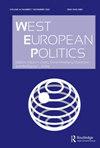不同却相同?欧洲联盟在执行方面的差异化一体化和灵活性
IF 4.5
1区 社会学
Q1 POLITICAL SCIENCE
引用次数: 6
摘要
本文章由计算机程序翻译,如有差异,请以英文原文为准。
Different yet the same? Differentiated integration and flexibility in implementation in the European Union
Abstract Differentiated integration (DI) and flexibility in implementation (FI) are two forms of differentiation that can be used to cope with heterogeneity among EU member states. Given the different ways in which they do so, this article asks whether DI and FI are alternatives for each other or whether they serve different functions in EU legislation. Based on a dataset that maps the occurrence of opt-outs and flexibility provisions in EU directives, the analysis shows that DI and FI tend to be used together. A qualitative analysis of directives that combine different levels of DI and FI shows that, within that overall pattern, DI is used to accommodate individual outliers, while FI is used to address widespread concerns among member states. This suggests that DI and FI are two forms of differentiation in the EU, which are used to address different aspects of a common underlying set of concerns.
求助全文
通过发布文献求助,成功后即可免费获取论文全文。
去求助
来源期刊

West European Politics
POLITICAL SCIENCE-
CiteScore
10.00
自引率
7.10%
发文量
58
期刊介绍:
West European Politics (WEP)has established itself as one of the most authoritative journals covering political and social issues in Western Europe. It has a substantial reviews section and coverage of all national elections in Western Europe. Its comprehensive scope, embracing all the major political and social developments in all West European countries, including the European Union, makes it essential reading for both political practitioners and academics.
 求助内容:
求助内容: 应助结果提醒方式:
应助结果提醒方式:


